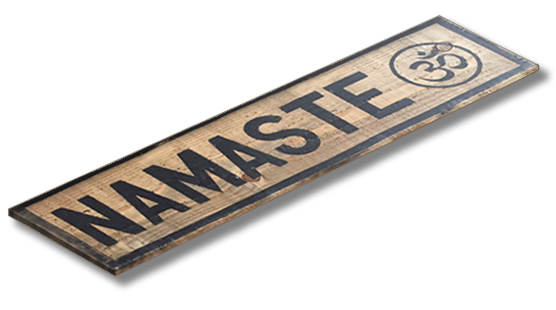What Does Namaste Mean?
When it came down to choosing a name for my business, the word Namaste (pronounced “Nah Mah Stay”) was a natural choice. Namaste is a Sanskrit word meaning “The divine in me honors the divine in you.” Since my concierge yoga practice is focused on a gentle, restorative approach based on the individual’s abilities, Namaste is the perfect description. Let me confirm, I am not an over-the-top Yogi who gets all caught up in the whole yoga persona that comes with some practitioners. I don’t drop Sanskrit terms into all my conversations. I don’t say “Namaste” instead of other phrases such as “Hello, Goodbye or Thank You”. I don’t even think I can do a headstand without falling over. Unlike a lot of the 20-30 year olds getting into Yoga training with perfect bodies, pretzel-like flexibility and perfect color coordinated Lululemon outfits, I’m a 51 year-old woman, working in corporate America most of my life, with arthritis and lower back pain caused me to find alternatives to prescription medication and taking handfuls of Motrin. Yoga was the perfect solution. It made me feel healthier and brought out the best in me. That quickly became my mission—to bring out the best in others.
Namaste Wellness Tip #1 – It all starts with breathing
According to a Yoga Journal blog by Kate Holcombe in 2012 entitled “Breathe Easy: Relax with Pranayama” you can use the pranayama breathing technique to break your unconscious breathing pattern and make the breath long, easeful, and smooth. Most people’s unconscious breathing patterns are anything but easeful and smooth; they tend to be tense, shallow, and erratic. When we are afraid or hear bad news, we often gasp—inhaling and then holding the breath. These breathing patterns can activate the sympathetic nervous system (often referred to as the “fight or flight response”). Not relaxing and restorative. When you learn how to breathe properly, you can support the parasympathetic nervous system and activate what is commonly known as the “relaxation response,” reducing stress and its effects on your body and mind. As a result, your resilience in the face of challenge or adversity increases and your mind becomes more focused and still.
Namaste Wellness Tip #2 – choosing the right poses for the individual
Every client is unique and has different areas that need attention. Beyond the very basic warm-up poses, yoga is not a one-size-fits-all proposition. A tailored approach works best to build a personalized yoga experience for each individual based on their ability, stamina and flexibility. The best news is that over time and with a little practice, everyone improves, gets stronger and feels better. When a client reaches a certain level, different, more advanced poses can be introduced. I have found this approach to be more effective than just taking general level classes in a studio.
Namaste Wellness Tip #3 – the best way to get an inactive body going
We all have parents, friends, neighbors or co-workers who need to get more physical activity into their lives.
Incidentally, I have heard every excuse in the book:
- “I’m not flexible enough to do Yoga.”
- “I would be embarrassed to do yoga badly in front all the more advanced students.”
- “I don’t look good in yoga clothes.”
- “Yoga irritates my sore back, knee, or shoulder.”
- “I don’t have time to get on a regular routine.”
- “I’m traveling during the week, classes don’t fit into my schedule.”
- “Yoga is for dancers.”
- “I can’t do a headstand, why would I want to?”
- “I can just watch a DVD once in a while.”
- “Yoga is too expensive.”
Now, all of the excuses listed above can be addressed with Concierge Yoga except one, “I don’t want to.” That excuse usually comes from a bad experience or just fear of the unknown. I find with a little bit of handholding, offering to have friends or family in the same session, that excuse usually disappears as well.
Conclusion
There is an actual pose for the term Namaste. To perform Namaste, we place the hands together at heart center, close the eyes and bow the head. It can also be done by placing the hands together in front of the third eye/forehead, bowing the head and then bringing the hands down to the heart. This is an especially deep form of respect. Although in the West the word “Namaste” is usually spoken in conjunction with the gesture. In India, it is understood that the gesture itself signifies Namaste and therefore, it is unnecessary to say the word while bowing. Not to worry, when we meet this will be the first pose we learn.


